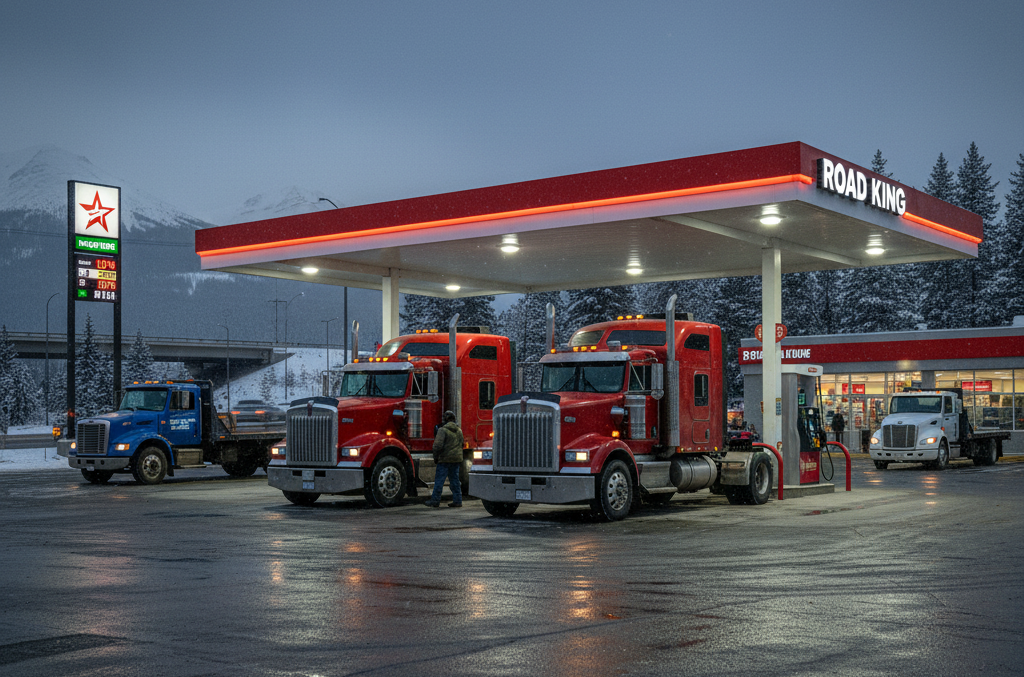What is the FMCSA?
The FMCSA stands for the Federal Motor Carrier Safety Administration. It’s an agency of the US Department of Transportation (DOT) set in 2000. Its main goal is to reduce accident risk across the commercial motor vehicle sector.
To achieve this, the FMCSA sets and enforces truck safety regulations that include a wide range of aspects. In particular, they cover driver qualification, the number of driving hours, vehicle maintenance, and medical examinations of drivers.
According to FMCSA regulations, trucking businesses must maintain accurate documentation, ensure driver qualification, and conduct vehicle maintenance. The agency conducts inspections and audits to monitor and enforce adherence. Non-compliance with the requirements can lead to legal penalties, such as fines or license suspension.
What Does The FMCSA Do?
The responsibilities of the FMSA involve researching, developing, and enforcing safety standards for trucking businesses. The main part of the agency’s activities is identifying high-risk carriers and scenarios. Potential hazards are prevented through regulations and corrective actions.
The other duty is to issue USDOT numbers and operating authority. They are the main DOT requirements for legal trucking operations.
The FMCSA also sets standards for vehicle inspections, driver checks, cargo securement, and medical examinations. In particular, the agency has requirements for securing oversized cargo during transportation or materials stored in the cabs.
Key Responsibilities of the FMCSA
Thus, the duties of the FMCSA include researching, developing, and enforcing safety standards. It aims to protect drivers and the public and ensure reliable vehicle operations. These regulations directly impact operations and activities of businesses. In particular, they involve requirements for licenses, insurance, vehicle inspection, and medical examinations.
- Setting safety regulations. The FMCSA develops safety rules and standards for commercial truck operations. It involves the HOS rules, standards for vehicle maintenance, and securing cargo rules. The agency also provides requirements for transporting specific types of cargo, such as overweight or hazardous items, aiming to minimize risks on the road.
- Issuing USDOT numbers and operating authority. The FMCSA provides licenses and permits to trucking companies. A USDOT number serves as an identification to track safety records and regulations compliance.
- Operating authority provides trucking companies a right to operate in multiple states. These documents are crucial for legal operations in the industry.
- Monitoring compliance. The FMCSA ensures compliance of trucking companies with DOT regulations. For that, the agency conducts audits and inspections. In case of violations, the FMCSA can issue fines, suspend operations, or conduct implement actions.
- Checking driver qualifications. The agency sets standards for obtaining and maintaining a Commercial Driver’s License (CDL). The FMCSA requires pre-employment and background checks to ensure a driver meets all necessary standards. CDL requirements help reduce the risk of accidents caused by unqualified drivers.
- Updating safety standards. The FMCSA constantly finds new ways to ensure road safety. The agency analyzes a pull of data and identifies accident risks. Thus, the FMCSA updates its requirements to maintain the safety.

FMCSA Regulations and Compliance
The FMCSA’s regulations are segmented into several programs. The aim is to ensure strict adherence to safety standards. By implementing these initiatives, the FMCSA enforces reliable transportation activities across the US.
Hours of Service (HOS) Regulations
The HOS rules help prevent driver exhaust and related road accidents. This sets the maximum time a driver can be behind the wheel without a rest. The HOS rules ensure drivers are rested and alert during operation. In particular, the limits are:
- Carriers can drive no longer than 11 hours after a 10-hour rest.
- The on-duty limit is 14 hours, including driving and non-driving activities.
- Rest breaks must be every 8 driving hours and last at least 30 minutes.
- Weekly work limits are 60 hours of driving in 7 days or 70 hours in 8 days.
CSA Program (Compliance, Safety, Accountability)
The CSA program is the system that evaluates and improves the trucking industry’s safety. It allows the FMCSA to target interventions at the most high-risk companies or drivers.
The program monitors safety performance through:
- Safety categories. The CSA categories include Unsafe Driving, HOS compliance, Vehicle maintenance, and more.
- Data collection. The CSA collects data from roadside inspections, accidents, and violations reports.
- Risk Assessment. The program evaluates companies in each category based on performance and identifies businesses with higher risk.
Vehicle Maintenance and Safety Inspections
It’s a vital part of preventing accidents amid equipment failures. Vehicle maintenance safety inspections ensure the proper condition of trucks and require promptly addressing all potential issues.
- Routine maintenance. Companies and drivers must conduct regular maintenance checks on vehicles. This includes brakes, lights, engines, and other critical components inspection.
- Inspections reports. All maintenance activities, such as inspections and repairs, must be documented.
Driver Qualification Files and Pre-Employment Checks
These requirements are needed to ensure the proper qualification of commercial drivers. It helps reduce the risk of accidents and improve overall safety. The FMCSA requires:
- Driver qualification files. Each driver must have a valid Commercial Driver’s License (CDL) that aligns with their trucks and cargo. The requirements also include medical certification, driving history, and training records.
- Pre-employment checks. Before hiring, companies must thoroughly check a diver’s background, experience, and driving record.
- Ongoing monitoring. Companies must update and review driver qualification files. It ensures proper and reliable operations.
FMCSA’s Safety Measurement System (SMS)
The SMS monitors safety performance in the trucking sector. It allows the FMCSA to focus on companies and carriers with poorer safety performance, helping improve overall safety.
- Data collection. The SMS collects data necessary for safety monitoring. It includes details from roadside inspections, crash reports, and violation records.
- Performance metrics. It evaluates the safety performance of trucking companies across several categories, such as Vehicle Maintenance or Hazardous Materials.
- Safety scores. Companies obtain scores according to their safety performance in each category. This identifies high-risk businesses or drivers and targets them for enforcement actions.
FMCSA Compliance in Practice
Ensuring compliance with FMCSA standards is essential for maintaining smooth operations. This also reduces the risk of costly penalties and suspension of operations. Here are some tips you can use to meet the regulations:
- Understand FMSA requirements. Be aware of the FMCSA’s standards and understand which aspects of your operations they involve. It’s the first step toward compliance.
- Regular training. Your drivers should undergo regular training. This keeps them aware of the latest regulations and how to comply with them. Keep informed. The FMCSA regularly updates its requirements. Review the FMCSA’s website or subscribe to updates to be aware of new rules.
- Maintain accurate records. Ensure all driver and vehicle documentation is complete and accurate. This involves driver qualification files and vehicle inspection logs.
- Use innovative technologies. Utilize technology to simplify compliance regulations. Such tools as instruments, electronic logging devices (ELDs), and fleet management software can help you track driver performance, working hours, and vehicle maintenance.
- Conduct regular inspections. Schedule vehicle maintenance activities and safety inspections and monitor the conduct. This prevents downtime and improper vehicle condition.
- Address violations. In case of any violation, address it promptly. Review the issue and implement corrective actions. It’s also important to reduce the risk of similar violation in the future.
- Be ready for FMCSA audits. Conduct preparation for FMCSA audits, keeping all necessary documents organized. Regularly check your operations to ensure they comply with FMCSA standards.

Recent Developments and Updates in the FMCSA Regulations
The FMCSA constantly updates its regulations to minimize potential risks on the roads. Being informed of these changes is essential for compliance and efficient operations. In 2024, the FMCSA proposed the following changes:
- The SMS updates. The FMCSA plans to simplify violation severity weights to more accurately reflect their impact, consolidate violations, and use proportionate calculations. In addition, the new SMS rules update its safety categories and focus more on recent violations.
- Drug and alcohol clearinghouse innovations. Starting in November of this year, drivers with a prohibited status will lose their CDL. The return-to-duty process will include meeting with a DOT professional, completing a treatment plan, and undergoing a return-to-duty and six follow-up tests.
- Automatic emergency braking implementation. These systems are becoming a standard in new vehicles. They automatically apply the brakes if a collision with a vehicle ahead is imminent. Their use isn’t a requirement of FMCSA yet, but the National Highway Traffic Safety Administration proposed to make them obligatory on all new vehicles. The rule isn’t finalized by now.
- Speed limiters in commercial trucks. The measure is expected to prevent drivers from exceeding a set speed, potentially around 68 mph. It’s expected to apply to new trucks with electronic engine control units.
Conclusion
The FMCSA is the basis of the US trucking industry’s safety and effectiveness. Its truck safety regulations help prevent accidents and ensure the smooth operation of commercial motor vehicles. Adherence to the FMCSA regulations reduces the risk of legal fines and penalties, prevents operational disruptions, and maintains smooth operations.
As the trucking sector evolves, all participants should stay informed about the updates in the regulations. The FMCSA constantly identifies potential risks and implements measures to minimize them.
With compliance with the FMCSA’s requirements, businesses can help create a safe environment and protect their operations from penalties or disputes.




